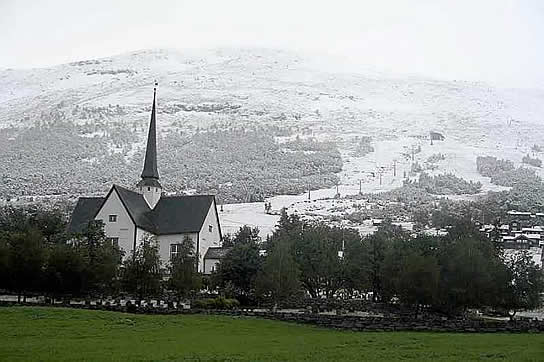

Camino de Santiago Hints and Tips
Kate and Corwen's Norwegian Adventure page 4
The next day we walked up the lush valley on the way to Dovre. We stopped for water at a house and they asked if we needed anything else, to use the computer, some food or anything. The kindness and openness of the Norwegian people never ceased to impress us on this walk.
This is Dovre town hall and council offices, it has dragons on it... It was actually nice to admire it as we had lunch in the restaurant opposite, not something you could say of much English municipal architecture!
This is Dovre church.
It is clad in massive sheets of stone, brought from a quarry some 20 miles away on the backs of donkeys, because the wooden logs the church is built from were starting to rot.
It is quite solemn on the outside.
Although it does have a lovely door-handle...
On the inside it is the usual odd conbination of Baroque carving and log cabin simplicity.
With the Ship of Life quite commonly seen in Norwegian churches. The verger was surprised to discover we don't have ships hanging in all the churches in England! This ship has a lot of cannons, the symbolic meaning of which we can only guess at...
The pulpit.
Back outside and there are Russian war graves in the churchyard.
We headed off out of Dovre after a stop at the supermarket for more instant mash, and a pair of gardening gloves for Corwen. Corwen's hands were really feeling the cold (he has Raynauds syndrome which makes your fingers go numb in the cold). From here there are no more shops for more than 100km of really difficult terrain so you have to carry all the food you need for however long it takes you to walk that far. The next 4 days walking is the hardest part of the journey, as the route goes up and over the high interior massif of Dovre Fjell, crossing the watershed. Significant parts of the route are above the treeline, and there are wolves, bears and wild muscox!
But first we checked in to the Pilgrim accommodation at Budsjord. Budsjord is a historic farm with all the old log buildings preserved. They have coach trips visit, and operate as a very select restaurant serving home cooked food in the farmhouse. They only provide overnight accommodation to Pilgrims, so we were lucky to be able to stay in such a fantastic place.
This is the cabin reserved for Pilgrims, you can see the old part on the right and a more recent extension on the left.
We lit the wood stove, and the owner kindly brought us a pot of coffee.
Kate made full use of the Fotbad. This footbath is famous enough that Eivind told us about it in Oslo, nearly 3 weeks before! It is a great treat for the footsore pilgrim with Bad Fots.
The stove was tucked into the old open fireplace, next to the cheese making kit.
We had a wonderful relaxing evening, playing a little music as we sat by the fire. The perfect preperation for the gruelling next few days. There was a Pilgrim visitors book, it was strange to read Alsion Raju's entry (the author of the guide book), the guide books author becomes a kind of third person on a walk like this as you are so dependent upon them, and often study their every word with great intensity! We also read of some Pilgrims who had had to give up their trip in July the previous year, after deep snow on Dovre. Yikes!
As we left the next day we got this view down onto Budsjord.
And back down the valley. It was very early as we needed to make good time over this section. The slower you go, the more food you need to carry, and food is heavy and makes you go slowly, so its a fine juggling act.
The normal wooden posts and red ribbons give way to the Olav's Way symbol painted onto stones up here.
We climbed for a couple of hours.
Soon the trees started to peter out, and then we were above the treeline. It was raining hard and the wind was crazy! We put on almost all our clothes and were still only just comfortable.
About noon we made it to Allemanroysa, a big cairn which marks the highest point of this part of the journey. Pilgrims have traditionally left stones here, so we had carried some pebbles from home to leave here.
Here they are.
They are still there now, I hope. Our packs were now about 40 grams lighter. Every little helps...
There was snow up here in hollows, which was quite impressive. I've never seen snow in August before.
There was also a lot of water. The path was at times almost impassable, some kind soul had put duckboards down in parts, though it was tricky balancing on them in such a strong wind that could blow you over if you missed your footing.
Thank goodness for trekking poles.
There were some impressive views of a 'magnificent desolation'.
'
A true wilderness landscape.
The path was well marked at least, as losing your way up here could be very very bad.
At last a tree!
This wildlife information board was interesting. Click on the picture to see a bigger version where you can read the text.
Late in the evening we descended back down to below the treeline.
This beautiful cabin was near the Furuhaugli campsite, where we spent the night in our tent. We passed it again the next morning and took a few pictures.
The sharp morning light made the birchbark shine a brilliant white.
How old are these logs I wonder.
There were a few goats on the road. Kate looks a little cautious in this photo, but its just a trick of the camera. We decided to walk along the E6 road for a bit as it was dangerously windy and wet on the higher ground.
It is weird when you come to a place like this, Dovregubbens Hall. An outpost of 'civilisation', or at least tourist tackiness in what seems like the middle of nowhere. Then you remember that although its taken nearly three weeks to walk here, you are still only 5 or so hours drive from Oslo.
Which is how this lot got here.
This is a particularly busy stretch of the E6, as there is more than one cow in sight.
It rained terribly, from mid morning onwards with no sign of stopping. We were starving so had to stop eventually and cook lunch regardless. There was no shelter anywhere, but at least there was a picnic table in this layby. Are you having fun yet Kate?
By the evening the rain had stopped and the sun came out.
So did the mosquitos! We had camped near a river for water and obviously had found a mossie hot spot. Kate sheltered in the tent while Corwen cooked dinner. Corwen was glad to have his mosquito head net, this was the only time we used it on the whole journey, but as it weighed only 60 grams I still think it was worth taking it.
It was a great place to camp.
The river at least meant we didn't go thirsty. Thank goodness for the invention of lightweight water filters!
The E6 here is lined with dramatic waterfalls and rocky streams.
We saw this sign in a picnic area. Apparantly male Muskoxes who have been unlucky in love are to be found wandering about on campsites and on the road sometimes. Scary! Sometimes German tourists try to stroke them. Not a good idea. Click for larger image.
This Saami encampment/tourist trap was interesting, They were very friendly and had some nice handcrafts, though most of them were too heavy to carry. We bought a little Saami flag. You can read more about the Saami people here.
They had a tame reindeer.
And some Saami tipis, called lavvu. We like tents a lot so this was great!
We took lots of photos to show to my friend Paul the Tipi maker, and so we could make a lavvu for ourselves later too. Did I mention we like tents?
As you come down off Dovre Fjell you pass this railway station, which from our height looked like part of the worlds most beautiful model railway layout.
We spent hours looking for the campsite at _______. The guidebook and road signs promised it was just a few kilometres away, but we kept walking and walking and walking... Eventually with evening coming on we saw it, still miles away and on the other side of a river. This was the bridge. It was quite a nice campsite though, although they charged for all the hot water and even the washing up water came from a coin operated machine! We bought beer in the office and chatted to the receptionist about Muskox.
Norwegian pedestrian crossings are indicated by this rather dapper gentleman. We wondered if it was a warning against possible teleportation by alien spaceships. Danger, being Smartly Dressed could result in Alien Abduction. No danger of us being beamed up then, clad from head to toe in smelly polyamide damp with bog water and encrusted with instant mashed potato and noodle spillages
If you ever wondered where to buy a bell tower to put on your Stabbur, this is the place, on the outskirts of Oppdal.

We forgot to take pictures of Oppdal, probably because it had the first supermarket since Dovre 5 days walk back. So here is a picture of Oppdal church in the snow taken by someone else. We spent a few hours eating and drinking more than we have ever eaten and drunken before. Oppdal looks like an American town, its qute odd, lots of Malls and car parks.
We walked out of Oppdal expecting to find the campsite the guidebook said was just after the Stolen Ski Senter. It wasn't there. It turns out that you must turn right after the ski senter and go downhill for a mile following waymarks that we didn't see and that the guidebook didn't mention. My advice is to walk out of Oppdal on the E6 if you want to stay at this campsite. Luckily we asked for directions at a farmhouse and he gave us a lift there in his pickup. We love the Norwegians!
We got there in the end and stayed a whole day in this hut to have a rest. It was wonderful!
There were some great constructions on this campsite, I guess folk extended their caravan a bit but just didn't know where to stop! There is a caravan in there somewhere...